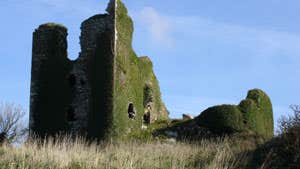The la Poer family built the Dunhill castle in the early 1200’s. There is some evidence of an earlier Celtic fort on the hilltop also. The town's name is derived from the Irish translation of the fort of the rock. The impressive silhouette comprises only about half a fifteenth century tower with bits of outer walls dating to the early thirteenth century.
Between the castle and church would have stood the medieval village of Dunhill which was basically a string of wooden houses. Attached to the front of the church was a small tower in which the priest lived.
The castle had an interesting and chequered history. The la Poer’s (Power) of Dunhill were infamous in the 14th century, as they launched many attacks on Waterford City. In 1345 they destroyed the area around city but were counter-attacked, taken prisoner and hanged. The remaining members of the Power clan join forces with the O’ Driscoll family. This alliance would attack Waterford many times over the next 100 years, with both success and failure. After a defeat in Tramore in 1368 the castle passed to the Powers of Kilmeaden. It remained in their control until the Cromwellian attack on Dunhill and its first capture (legend of gunners and buttermilk) in 1649.
Once regarded as impregnable, the castle was besieged and sacked, with the outer defences destroyed as well as tower beside the church. Fate of last Lord of Dunhill and Kilmeaden, John Power, and his family were unknown. The Castle and lands were then given to Sir John Cole with the church given to Waterford Corporation. Cole and his decedents never lived in the castle and the church was disused, with the result that timbers rotted and both fell into ruins during the 1700’s. More deterioration was recorded in 1912 when the east wall of the castle collapsed during a storm.
From the Castle why not continue your walk over to Annestown Beach and catch some of the beautiful ocean views.
